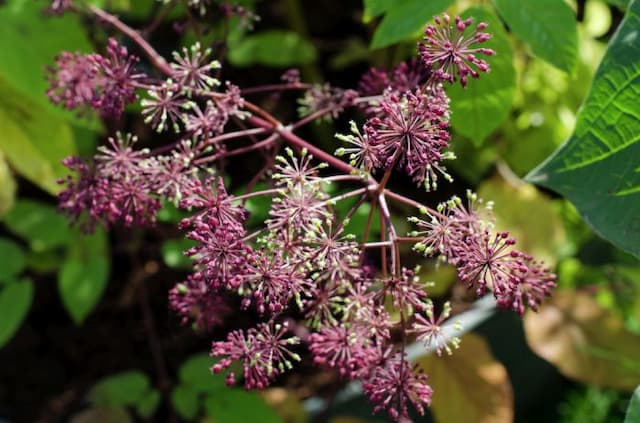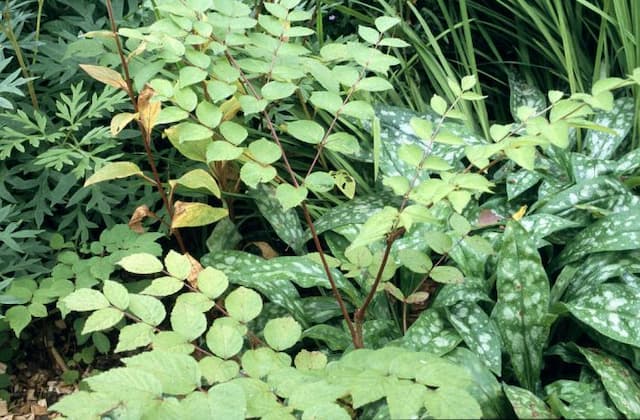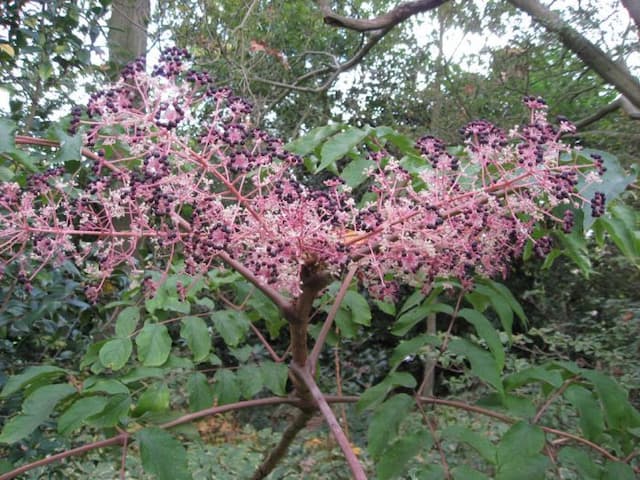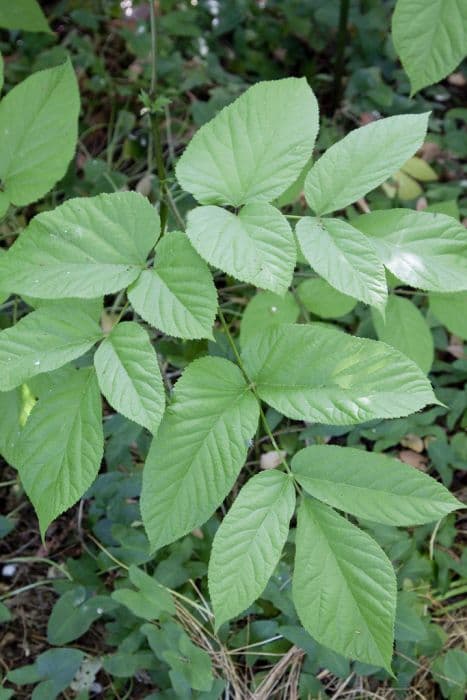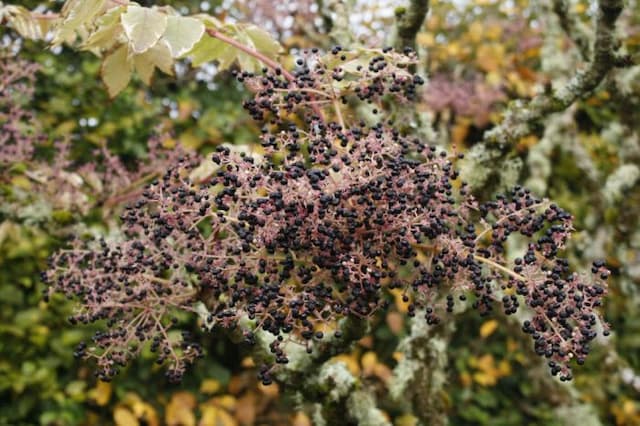Japanese Aralia Fatsia japonica

ABOUT
The Fatsia japonica, commonly known as Japanese aralia, is a robust, evergreen shrub known for its lush and glossy foliage. The leaves are the most striking feature, being large, palmate, and deeply lobed, resembling an open hand with fingers. They can appear almost leathery in texture, with a rich, dark green color that adds to a tropical aesthetic. These leaves are borne on sturdy stems that can give the plant a somewhat architectural look. Japanese aralia produces small, white globular flower clusters that are followed by black, non-edible berry-like fruits, though the plant is primarily cultivated for its decorative leaves rather than its flowers or fruit. The overall appearance of the plant is dense and bushy, making it a popular choice for creating a lush, green backdrop in gardens or as a statement houseplant for interior decorating. It provides a striking visual impact with its bold leaves and can bring an exotic touch to both indoor and outdoor settings.
About this plant
 Names
NamesFamily
Araliaceae.
Synonyms
Japanese Aralia, Glossy-leaf Paper Plant, Fatsia, Paperplant, Fig-leaf Palm, Fatshedera.
Common names
Aralia japonica, Aralia sieboldii, Fatsia sieboldii
 Toxicity
ToxicityTo humans
The Japanese aralia is considered to be only mildly toxic to humans. If ingested, it may cause irritation of the mouth, lips, throat, and skin due to the presence of saponins, which are chemical compounds known to produce a soapy lather when mixed with water. Symptoms of poisoning can include vomiting, diarrhea, and a burning sensation in the mouth. It is important to seek medical attention if any part of the plant is consumed, particularly by children who might be more sensitive to its toxic effects.
To pets
For pets, the Japanese aralia is also mildly toxic. If ingested by pets such as dogs or cats, it can cause similar symptoms as in humans, such as vomiting, diarrhea, and oral irritation. Ingesting the plant can result in drooling, pawing at the mouth, reduced appetite, and a general sense of malaise. It's crucial to consult a veterinarian if you suspect your pet has eaten any part of this plant to receive appropriate care.
 Characteristics
CharacteristicsLife cycle
Perennials
Foliage type
Evergreen
Color of leaves
Green
Flower color
White
Height
6-10 feet (1.8-3 meters)
Spread
5-8 feet (1.5-2.4 meters)
Plant type
Shrub
Hardiness zones
8
Native area
Japan
Benefits
 General Benefits
General Benefits- Ornamental Value: Fatsia japonica, commonly known as Japanese aralia, has large, glossy, and deeply lobed leaves that make it an attractive ornamental plant for gardens and indoor spaces.
- Shade Tolerance: Japanese aralia can thrive in shaded areas where other plants might struggle, making it versatile for different garden settings.
- Low Maintenance: It requires relatively little care, which is ideal for gardeners looking for plants that do not need frequent attention.
- Privacy Screen: Because of its dense foliage, Japanese aralia can be used as a natural privacy screen or to hide unsightly areas in a landscape.
- Container Gardening: This plant is well-suited for container gardening, which makes it an excellent choice for balconies, patios, or indoor use.
- Wildlife Attraction: Its flowers can attract beneficial insects such as bees, and its berries provide food for birds during the fall and winter.
- Architectural Structure: The unique shape and texture of the plant's leaves add architectural interest to garden designs.
- Variety of Climates: Japanese aralia can adapt to a variety of climates, although it prefers temperate regions, it can be grown in many different areas with suitable care.
 Medical Properties
Medical PropertiesThis plant is not used for medical purposes.
 Air-purifying Qualities
Air-purifying QualitiesThis plant is not specifically known for air purifying qualities.
 Other Uses
Other Uses- Ornamental screen or hedge: Fatsia japonica, commonly known as Japanese Aralia, can be used to create dense screens or hedges for privacy due to its large, lush foliage.
- Urban gardening: Japanese Aralia is suitable for urban environments as it tolerates pollution and can thrive in shaded areas where other plants may struggle.
- Frost-resistant planting: In temperate climates, Japanese Aralia serves as an excellent frost-resistant plant, making it ideal for outdoor spaces that experience mild winters.
- Bonsai: Due to Japanese Aralia's ability to adapt to pot culture, it can be trained as a bonsai, providing a unique and artistic plant form for enthusiasts.
- Theme gardens: Japanese Aralia is often included in Japanese or Asian-themed gardens to add authenticity and complement traditional design elements.
- Container planting: Its tolerance for shade and ability to grow in containers makes Japanese Aralia a suitable plant for patios, balconies, or indoor spaces with indirect light.
- Foliage for flower arrangements: The distinct, large leaves of Japanese Aralia can be used in floral arrangements to add a tropical and lush feel to bouquets.
- Coastal areas planting: Japanese Aralia's tolerance for wind makes it a good planting choice in coastal areas that require sturdy and resilient vegetation.
- Dramatic underplanting: When planted underneath taller trees or shrubs, Japanese Aralia adds a dramatic visual layer of contrast with its bold foliage, enhancing overall garden texture.
- Film and theatre prop: Due to its striking appearance, Japanese Aralia can be used as a prop in film and theatre productions set in dense, jungle-like environments.
Interesting Facts
 Feng Shui
Feng ShuiThe Paper plant is not used in Feng Shui practice.
 Zodiac Sign Compitability
Zodiac Sign CompitabilityThe Paper plant is not used in astrology practice.
 Plant Symbolism
Plant Symbolism- Resilience: Fatsia japonica, commonly known as Japanese aralia, is a hardy plant that can thrive in a variety of conditions, symbolizing an individual's ability to persevere through adversity.
- Growth: The plant's vigorous growth habit signifies personal growth and the capacity to expand one’s horizons.
- Diversity: With its broad and deeply lobed leaves, the Japanese aralia represents diversity and the embracing of differences within unity.
- Protection: Due to its thick foliage, it is often viewed as a symbol of protection and sanctuary, offering a shield from the outside world.
- Secrets: Some cultures regard the dense leaves as a hiding place, thus the plant can sometimes symbolize the holding of secrets or mysteries.
 Water
WaterThe Japanese Aralia requires consistent moisture, so water when the top inch of soil feels dry to the touch. Water thoroughly, allowing water to penetrate the roots, but be careful not to overwater. On average, watering every 7 to 10 days should suffice, but this will vary depending on the humidity and temperature. Aim to provide one to one and a half gallons of water per watering session, ensuring even soil moisture without waterlogging.
 Light
LightJapanese Aralia performs best in bright, indirect light but can tolerate some shade. Position it in a spot that receives filtered sunlight, avoiding direct sun exposure which may scorch its leaves. North-facing or east-facing rooms with plenty of natural light are ideal locations for the plant.
 Temperature
TemperatureJapanese Aralia thrives in temperatures between 60 and 75 degrees Fahrenheit and can tolerate a minimum temperature of 50 degrees Fahrenheit. Avoid exposing the plant to temperatures below 50 degrees Fahrenheit as this can cause damage to the foliage. It is well suited for the average indoor temperature found in most homes.
 Pruning
PruningPrune Japanese Aralia to maintain its shape and remove any dead or damaged leaves. The best time for pruning is in the late winter or early spring before new growth begins. Pruning can be performed every year or as needed to keep the plant looking tidy and encourage bushier growth.
 Cleaning
CleaningAs needed
 Soil
SoilJapanese Aralia prefers a well-draining soil mix rich in organic matter with a slightly acidic to neutral pH of 6.0 to 7.5. A recipe for an ideal soil mix is one part peat, one part pine bark, and one part perlite or coarse sand, ensuring good aeration and moisture retention.
 Repotting
RepottingJapanese Aralia should be repotted every 2-3 years or when rootbound. It is best to repot in the spring using the previously described soil mix and a pot that is slightly larger than the previous one.
 Humidity & Misting
Humidity & MistingJapanese Aralia thrives at humidity levels of 50% or higher. It is tolerant of lower humidity but will appreciate a humidifier, pebble tray with water, or regular misting to maintain optimal conditions for growth.
 Suitable locations
Suitable locationsIndoor
Place Japanese Aralia in bright, indirect light and keep soil moist.
Outdoor
Plant Japanese Aralia in partial shade; shelter from strong winds.
Hardiness zone
8-11 USDA
 Life cycle
Life cycleThe life of Fatsia japonica, commonly known as Japanese Aralia, begins when the seeds germinate, ideally in a warm and moist environment. The seedlings emerge with a pair of small leaves and, with sufficient light and water, quickly develop into young plants. Japanese Aralia experiences a vegetative phase where it focuses on leaf growth, forming its characteristic large, glossy, and deeply lobed leaves while establishing a strong root system. Once mature, usually after several years, it enters the reproductive stage, producing white, rounded flower clusters in the fall or early winter, which attract pollinators. After pollination, small black berries develop, containing the seeds for the next generation. The plant may live for many years, continually producing new leaves, flowers, and seeds in a perennial cycle.
 Propogation
PropogationPropogation time
Spring to summer
The most popular method of propagation for the Japanese aralia (Fatsia japonica) is through semi-hardwood cuttings. Typically, the best time to take these cuttings is during the late summer months. A healthy parent plant is chosen, and cuttings are taken that are about 4 to 6 inches (10 to 15 centimeters) long, with several sets of leaves. The lower leaves are removed, and the cut end of the cutting is often dipped in a rooting hormone to enhance root development. These prepared cuttings are then inserted into a pot filled with a mix of peat and perlite or a free-draining potting mix. The cuttings should be kept in a warm, humid environment with indirect light until they root, which usually takes several weeks. Once rooted, the young plants can be transplanted into individual pots and grown on until they are ready to be planted outside.

